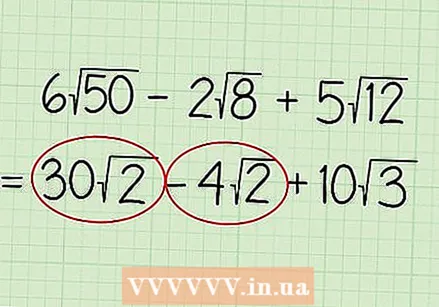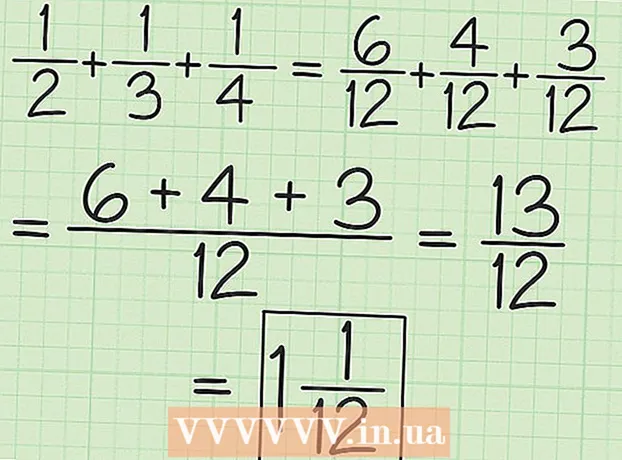Author:
Judy Howell
Date Of Creation:
27 July 2021
Update Date:
1 July 2024

Content
To add and subtract square roots, you must combine square roots with the same square root. This means that you can add (or subtract) 2√3 from 4√3, but this does not apply to 2√3 and 2√5. There are many cases where you can simplify the number under the square root sign to combine like terms and add and subtract square roots freely.
To step
Part 1 of 2: Mastering the basics
 Simplify the terms under the square roots if possible. To simplify the terms under the root signs, try to factor them into at least one perfect square, such as 25 (5 x 5) or 9 (3 x 3). Once you've done this, you can draw the square root of the perfect square and place it outside the square root marks, leaving the remaining factor under the square root. In this example we start from the assignment 6√50 - 2√8 + 5√12. The numbers outside the square root are the coefficients and the numbers below we call the square root numbers. Here's how you can simplify the terms:
Simplify the terms under the square roots if possible. To simplify the terms under the root signs, try to factor them into at least one perfect square, such as 25 (5 x 5) or 9 (3 x 3). Once you've done this, you can draw the square root of the perfect square and place it outside the square root marks, leaving the remaining factor under the square root. In this example we start from the assignment 6√50 - 2√8 + 5√12. The numbers outside the square root are the coefficients and the numbers below we call the square root numbers. Here's how you can simplify the terms: - 6√50 = 6√ (25 x 2) = (6 x 5) √2 = 30√2. You have decomposed "50" into "25 x 2" and then placed "5" outside the root (the root of "25"), leaving "2" below the root sign. Then multiply "5" by "6", the number that was already outside the square root sign, to get 30 as the new coefficient.
- 2√8 = 2√ (4 x 2) = (2 x 2) √2 = 4√2. Here you have decomposed "8" into "4 x 2" and then pulled the root of 4 so that you are left with "2" outside the root sign, and a "2" below the root sign. Then you multiply "2" by "2", the number that was already outside the square root sign, to get 4 as the new coefficient.
- 5√12 = 5√ (4 x 3) = (5 x 2) √3 = 10√3. Here you have divided "12" into "4 x 3" and then pulled the root of 4 so that you are left with "2" outside the root sign, and a "3" below the root sign. You then multiply "2" by "5", the number that was already outside the square root sign, to get 10 as the new coefficient.
 Circle any terms with corresponding square roots. Once you have simplified the square root numbers of the given terms, you are left with the following equation: 30√2 - 4√2 + 10√3. Since you can only add or subtract equal roots, circle those terms with the same root, in this example: 30√2 and 4√2. You can compare this to adding or subtracting fractions, where you can only add or subtract the terms if the denominators are equal.
Circle any terms with corresponding square roots. Once you have simplified the square root numbers of the given terms, you are left with the following equation: 30√2 - 4√2 + 10√3. Since you can only add or subtract equal roots, circle those terms with the same root, in this example: 30√2 and 4√2. You can compare this to adding or subtracting fractions, where you can only add or subtract the terms if the denominators are equal.  If you are working with a longer equation and there are multiple pairs with matching square roots, you can circle the first pair, underline the second, put an asterisk on the third, and so on. Sequencing like terms will make it easier for you to visualize the solution.
If you are working with a longer equation and there are multiple pairs with matching square roots, you can circle the first pair, underline the second, put an asterisk on the third, and so on. Sequencing like terms will make it easier for you to visualize the solution.  Calculate the sum of the coefficients of the terms with equal roots. Now all you have to do is calculate the sum of the coefficients of the terms with equal roots, ignoring the other terms of the equation for a while. The square root numbers remain unchanged. The idea is that you indicate how many of that type of square root number there are, in total. The mismatched terms can remain as they are. Here's what you do:
Calculate the sum of the coefficients of the terms with equal roots. Now all you have to do is calculate the sum of the coefficients of the terms with equal roots, ignoring the other terms of the equation for a while. The square root numbers remain unchanged. The idea is that you indicate how many of that type of square root number there are, in total. The mismatched terms can remain as they are. Here's what you do: - 30√2 - 4√2 + 10√3 =
- (30 - 4)√2 + 10√3 =
- 26√2 + 10√3
Part 2 of 2: More practice
 Do example 1. In this example, you add the following square roots: √(45) + 4√5. You must do the following:
Do example 1. In this example, you add the following square roots: √(45) + 4√5. You must do the following: - Simplify √(45). First you can dissolve it as follows √ (9 x 5).
- Then you pull the square root of nine and you get "3", which you then place outside the square root. So, √(45) = 3√5.
- Now you add the coefficients of the two terms with matching roots to get your answer. 3√5 + 4√5 = 7√5
 Do example 2. The following example is this exercise: 6√(40) - 3√(10) + √5. You need to do the following to fix this:
Do example 2. The following example is this exercise: 6√(40) - 3√(10) + √5. You need to do the following to fix this: - Simplify 6√(40). First you can decompose "40" into "4 x 10", and you get 6√(40) = 6√ (4 × 10).
- Then you calculate "2" of the square "4", and multiply this by the current coefficient. Now you have 6√ (4 × 10) = (6 x 2) √10.
- Multiply the two coefficients and you get 12√10’.’
- The statement now reads as follows: 12√10 - 3√(10) + √5. Since the first two terms have the same root, you can subtract the second term from the first and leave the third as it is.
- You love now (12-3)√10 + √5 about, which can be simplified to 9√10 + √5.
- Do example 3. This example goes as follows: 9√5 -2√3 - 4√5. None of the roots are squared, so no simplification is possible. The first and third terms have equal roots, so their coefficients can be subtracted from each other (9 - 4). The square root number remains the same. The remaining terms are not the same, so the problem can be simplified to5√5 - 2√3’.’

 Do example 4. Suppose you are dealing with the following problem: √9 + √4 - 3√2 You should now do the following:
Do example 4. Suppose you are dealing with the following problem: √9 + √4 - 3√2 You should now do the following: - Because √9 equals √ (3 x 3), you can simplify this: √9 is becoming 3.
- Because √4 equals √ (2 x 2), you can simplify this: √4 becomes 2.
- Now the sum 3 + 2 = 5.
- Because 5 and 3√2 are no equal terms, there is nothing left to do now. Your final answer is 5 - 3√2.
 Do example 5. Let's try to sum up square roots that are part of a fraction. As with a regular fraction, you can now only calculate the sum of fractions with the same numerator or denominator. Let's say you are working with this problem: (√2)/4 + (√2)/2Now do the following:
Do example 5. Let's try to sum up square roots that are part of a fraction. As with a regular fraction, you can now only calculate the sum of fractions with the same numerator or denominator. Let's say you are working with this problem: (√2)/4 + (√2)/2Now do the following: - Make sure these terms have the same denominator. The lowest common denominator or denominator that is divisible by both "4" and "2" is "4".
- So, to make the second term ((√2) / 2) with a denominator 4, you have to multiply both the numerator and the denominator by 2/2. (√2) / 2 x 2/2 = (2√2) / 4.
- Add the denominators of the fractions while keeping the denominator the same. Just do what you would when adding fractions. (√2)/4 + (2√2)/4 = 3√2)/4’.’
Tips
- You should always simplify square root numbers in front of you are going to determine and combine equal square root numbers.
Warnings
- You may never combine unequal square root numbers.
- You may never combine an integer and a square root. So: 3 + (2x) can not are simplified.
- Note: "(2x) is the same as "(√(2x)’.



